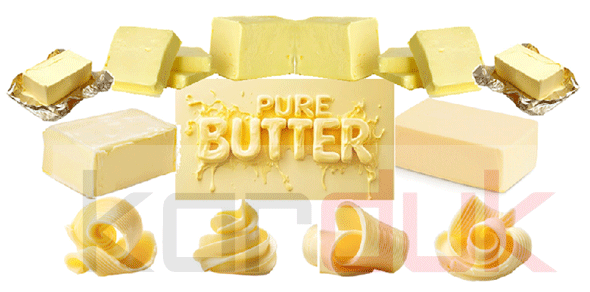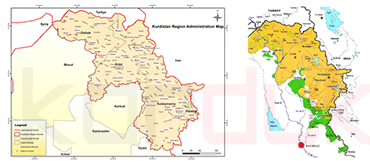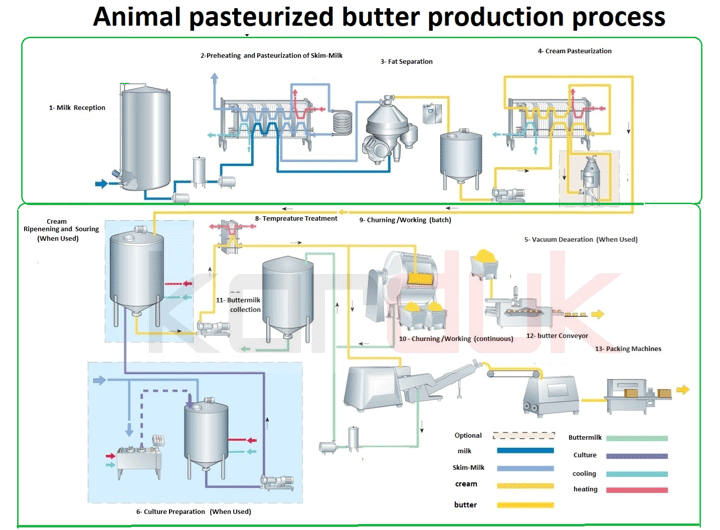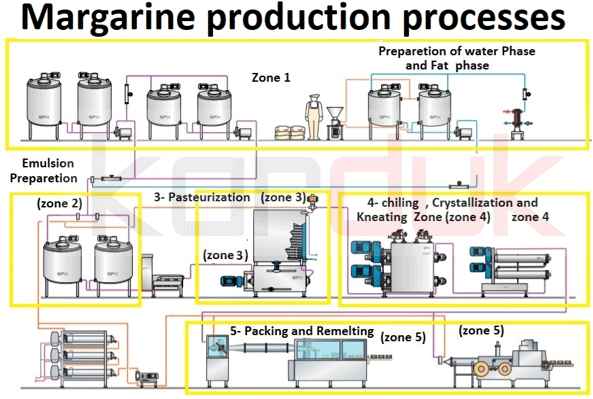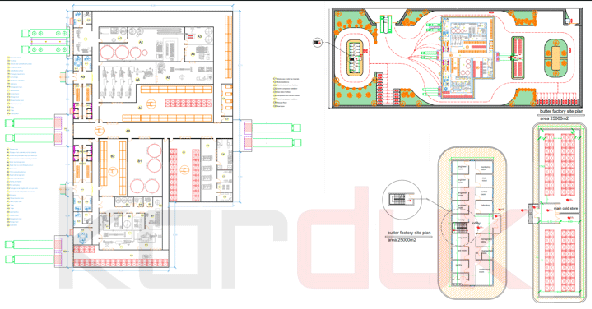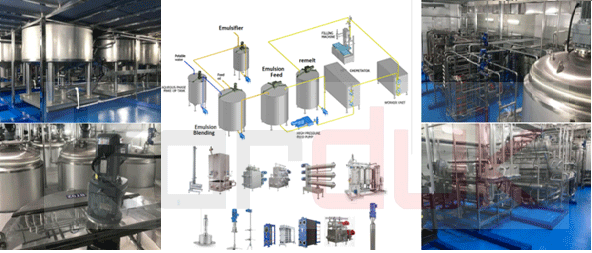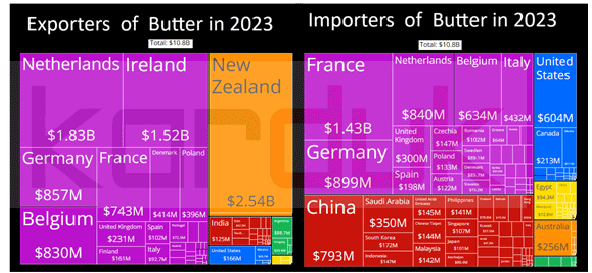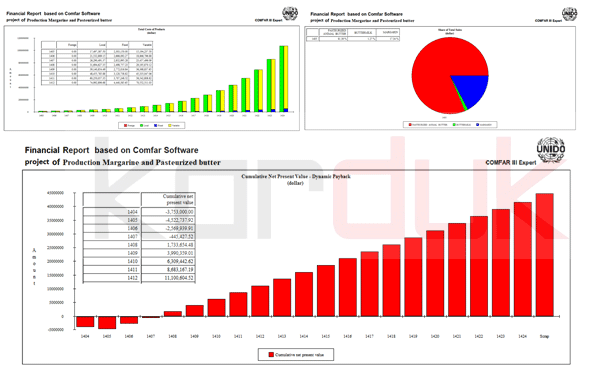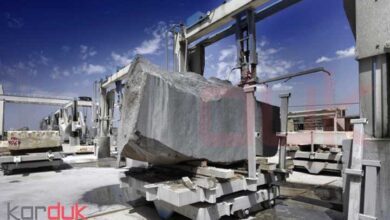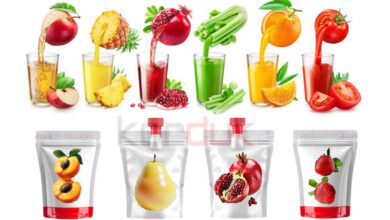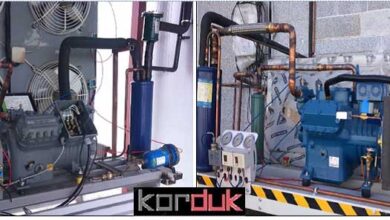
Feasibility Studies of Production Pasteurized Margarine and Butter
In Feasibility Studies of Production Pasteurized Margarine and Butter, the Technical, Financial, and Economic aspects of the project are explained.
Project Description:
Margarine and Pasteurized animal Butter is the most popular semi -solid fat – rich dairy product . Animal Butter is manufactured from dairy cream using a churning process. The churning process results in a water-in-oil emulsion.. normal butter contains salt , trace amounts of protein, calcium, phosphorous, and various fat-soluble vitamins (A, D, and E).
Product is a fine-crystalline nutrient consisting of a mixture of various Vegetable oils, water and skimmed milk. production generally consists : Preparation of water phase and oil phase, Emulsification, Cooling, crystallization, kneading and resting and Packaging
Project Access to the Infrastructures
- Access to Water Resources
Region of Project with temperate weather over the year, is influenced by Mediterranean climate. Generally, having more than 300 mm of rainfall and The complex has no problem in supplying the required water
-
Access to power supply infrastructure
In fact, today, any economic activity is relied on energy supply. Thus, the way of energy supply and its value play an important role in the progress and prosperity of different economic sectors. Considering that province has a combined cycle power plant and several other power Generation plants are under construction in the province, it is expected that there will be no problem in terms of power supply in the province.
-
Access to transportation infrastructure
The first and most important way for transportation, especially in region , is land routes and roads. Main entry routes into the province are completely asphalted and are becoming main road and most of secondary roads are asphalted. This complex is also located next to the main road towards Erbil .
-
Access to the telecommunication infrastructure
In modern era which is called communication age, the importance of telecommunication infrastructure is felt more than ever, and this Complex located in Kurdistan Region of the Republic of Iraq (KRI) has no problem in terms of telecommunication and the provision of its infrastructure, and this infrastructure is practically provided in most parts of the province.
Technical Specifications of plan |Feasibility Studies of Production Pasteurized Margarine and Butter
The International Dairy Federation (IDF) has introduced a standard concerning butters and spreads: IDF Standard 166:1993, “Guidelines for Fat Spreads”. These guidelines are intended to provide a broad framework permitting the development of more specific group or individual standards, according to the requirements of individual countries.
DEFINITIONS |Feasibility Studies of Production Pasteurized Margarine and Butter
Fat spread: A fat spread is a food in the form of an emulsion (water-in-oil type), comprising principally an aqueous phase and edible fats and oils.
Edible fats and oils: Foodstuffs mainly composed of triglycerides of fatty acids. They are of vegetable, animal, milk or marine origin.
BUTTER
product is usually divided into two main categories:
- Sweet cream butter
- Cultured or sour cream butter made from bacteriologically soured cream Butter can also be classified according to salt content: unsalted, salted and extra salted.
Until the late 19th century, butter was still made from cream that had been allowed to sour naturally. The cream was then skimmed from the top of the milk and poured into a wooden tub. Butter was made by hand in churns. The natural souring process is very sensitive, and infection by foreign microorganisms often spoiled the result.
process of Animal pasteurized butter production
The steps of process in batch and continuous production of cultured butter are as follows:
- Milk reception
- Preheating and pasteurization of skim milk
- Fat separation
- Cream pasteurization
- Vacuum deaeration, when used
- Culture preparation, when used
- Cream ripening and souring, when used
- Temperature treatment
- Butterfat Crystallization
- Treatment of fat
- Churning/working , continuous
- Buttermilk collection
- Butter silo with screw conveyor
- packaging machines
CONTINUOUS PRODUCTION| Feasibility Studies of Production Pasteurized Margarine and Butter
Method of continuous butter-making was resumed in the 1940s , include three different processes, all based on the traditional methods: churning, centrifugation and concentration or emulsifying. One of the processes, based on conventional churning, was the Fritz method.
This now predominates in Western Europe. In machines based on this method, butter is made in more or less the same way as by traditional methods. The butter is basically the same, except that it is somewhat matt and denser as a result of uniform and fine water dispersion.
THE MANUFACTURING PROCESS
In industrial method the cream is prepared in the same way as for conventional churning before being continuously fed from the ripening tanks to the butter-maker. The cream is first fed into a double-cooled churning cylinder fitted with beaters that are driven by a variable-speed motor. Rapid conversion takes place in the cylinder and, once completed.
Butter and curd grains are transferred to the separation section, also called the first working section, where the butter is separated from the curd. First washing of the Butter beans are carried along the way with the cooled curd circulating. The separation section is equipped with a screw that starts the butter work and simultaneously transports it to the next stage.
As it leaves the separation section, the butter passes through a conical channel and a perforated plate, the squeeze – drying , where any remaining buttermilk is removed. The butter grains then proceed to the second working. Each working section has its own motor, so that they can operate at different speeds for optimum results. Normally, the first screw rotates at twice the speed of the screw in the second section.
Following the last working stage, salt may be added by a high-pressure injector in the injection chamber The next section, the vacuum working, is connected to a vacuum pump. In this section, it is possible to reduce the air content of the butter to the same level as for conventionally churned butter.
The final working stage is made up of four small sections, each of which is separated from the adjacent one by a perforated plate.
Perforations of different sizes and working impellers of different shapes are used to optimize treatment of the butter. In the first of these small sections, there is also an injector for final adjustment of the moisture content. Once regulated, the moisture content of the butter deviates less than ~ 0.1%, provided the characteristics of the cream remain the same.
Transmitters for moisture content, salt content, density and temperature can be fitted in the outlet from the machine. Signals from the instruments can be used for automatic control of these parameters. The finished butter is discharged from the end nozzle as a continuous ribbon into the butter silo, for further transport to the packing machines.
For more information you can contact Karduk.inc via WhatsApp, Telegram or E-mail.
- Phone: +982166418908
Email: karduuk@gmail.com
The Process Line and Margarine Block| Feasibility Studies of Production Pasteurized Margarine and Butter
The margarine production line processes are structured around two blocks as follows:
- Typical “dairy block “with cream concentration, pasteurization and cooling
- A typical “margarine block” with preparation of the mix and phase inversion accompanied by working and cooling.
Process starts with pasteurized cream of 35 to 40 % fat content. the cream temperature must be adjusted to 60 – 70 °C before it enters the cream concentrator, a hermetic centrifugal machine. The degree of concentration, the cream fat content, is automatically controlled by the control device.
Fat contents of up to 82 % can be attained, following fat standardization, the cream is cooled to 18 – 20 °C, before being routed to a holding/pre-crystallization tank.
This part of the process line starts with a batching station where the product mix is prepared. Various ingredients are mixed together; Thus, concentrated cream is mixed with appropriate volumes of vegetable oil, salt and water phase, in that order. After thorough mixing, the mixture is pumped into a buffer tank. A new batch can then be prepared.
The process is continuous from the buffer tank, from which the product mix is taken to the high-pressure pump. It is then fed into the scraped-surface coolers, where phase inversion takes place. Before final cooling, the spread is held and worked by pin rotors.
Leaving the final cooling stage, the product enters the storage silo, from where it is pumped into the filling machine. The whole process is controlled and monitored by plc
Dairy block
- Cream tank
- Plate heat exchanger
- Centrifugal cream concentrator
- Cream standardization
- Pre-crystallization tanks
Margarine block
- Salt dosage
- Vegetable oil tanks
- Aroma dosage
- Mixing
- Buffer tank
- High-pressure pump
- Scraped-surface cooler
- Pin rotors
- Silo with screw conveyor in the bottom
- Packing system
- Cold Storage
- CIP equipment washing system
CIP Cleaning the production line is an essential part of the manufacturing process of a margarine production unit. A modern margarine unit has to be cleaned regularly since the margarine production. CIP has special storage tanks for the process CIP has special storage tanks for the process and if several production lines are installed in a factory,
It is possible to set parallel CIP cleaning paths which provides a significant reduction in cleaning time and costs.
The ISIC code of product |Feasibility Studies of Production Pasteurized Margarine and Butter
The International Standard Industrial Classification of All Economic Activities (ISIC) is the international reference classification of productive activities. Its main purpose is to provide a set of activity categories that can be utilized for the collection and reporting of statistics according to such activities. The ISIC code of the products of this plan is as follows:
- Pasteurized butter ,a mixture of animal butter and vegetable oil spread: 1520512777
- solid margarine: 1514512408
- Types of pasteurized butter: 1520412709
- Butter is a mixture of animal butter and vegetable oil: 1520412717
Buildings required for the project implementation
- The building space required for the production, administrative and headquarters departments, according to the site plan and layout of the production lines, is as follows:
- Production Building of Pasteurized butter 1500 Mr2
- Production Building of Margarine 1,200 Mr2
- Warehouse of raw dry materials and spare parts 350 Mr2
- Colling Building 400 Mr2
- Repairmen workshop
- Lab and R&D Building 300
- Welfare and Office (Administrative building) 400
- Facilities buildings
- Loading platform
- Security and janitor
For more information you can contact Karduk.inc via WhatsApp, Telegram or E-mail.
- Phone: +982166418908
Email: karduuk@gmail.com
Equipment and Machinery of production Margarin
The Machinery and Equipment of Margarin production required for the Technical services is as follows:.
- steam boiler(5 ton) 60 to 90 degrees
- Chiller(20 ton ) and cooling water with steam control and heat exchanger
- Primary water storage tank
- Hardening and water purifiers devices and RO
- Steel tank for storing purified clean wate
- Double-walled steel tanks for hot water
- Vegetable oil storage tanks with transfer pumps
- Oil flavor and color purification equipment with transfer pumps
- Double-walled steel oil tanks with heater and transfer pump
- Additives mixer
- Double wall emulsification tank under vacuum
- Special pumps for transferring densed liquid
- Buffer tanks for storage of semi-finished goods
Pasteurization system with heat exchanger for water and oil
- Cooling tanks
- Mixer and perfector for deep crystallization of margarine
- Ice Bank
- Remelt system and return to the mixer
- CIP facilities
- Final product tank for transfer to packaging
- Margarine bulk filling and packaging machines
- Tracking and Piping system
Equipment and Machinery of Animal butter and buttermilk production line
Machinery and Equipment of Animal butter and buttermilk production line is as follows:.
- Cream storage tank
- Double-walled preheated cream tanks
- Tank and mixer of landing materials
- densed liquid transfer pumps
- Mixer and homogenizer
- Buffer tanks for storage of semi-finished products
-
Pasteurizer
- Equipment for transferring cream to the churning
- Churn machine
- Buttermilk storage tank
- Butter washing system to clean the remaining buttermilk
- Salting is the final flavoring Butter
- Bulk filling and Small weight packaging machines
- Torching and piping system
World Trade of Butter
In 2023, global trade of Butter reached $10.8B, reflecting a 10.7% decrease from 2022, when trade totaled $12.1B. Among the 1217 products traded in 2023, Butter ranked 346 in global trade value, accounting for 0.048% of world trade.
Exports and Imports
In 2023, the leading exporters of Butter were New Zealand ($2.54B), Netherlands ($1.83B), and Ireland ($1.52B). The top importers were France ($1.43B), Germany ($899M), and Netherlands ($840M).
Financial Projection:
In this chapter, the financial and economic graphs of fixed and circulating capital, as well as operational costs of production are shown.
According to the finished price of the products and the annual profit of the production as well as the examination of the results performed by the COMFAR software, this project has an acceptable status from the point of view of expertise, and it is reliable from the financial point of view, The obtained output results does not show any important specific weakness for this project.
Product Sales Ratio:
The largest amount of sales is devoted to animal butter due to the high price of raw materials. It is obvious that the rate of annual price increase during the production period It is applied annually based on the discount rate. Below is the circular and column chart that shows this situation better.
Dynamic Pay Back Period (DPBP)
Comfar’s calculations show that the normal capital return period will be three years and the moving cumulative capital return period of the project will be four years with the application of a discount rate of 25 % on costs and revenues.
Summary of Study Results:
- The proposed Capacity of Production Margarine and Pasteurized butter in Relation to the Size of the Marker and Province can be Increased due to the higher Quality and Competitive Price of Products Compared to Domestic and Foreign competitors.
- Executive Experience of more than a Decade in the construction and effective communication with the distribution market network of the dairy industry as well as the lack of production butters in the country production of pasteurized butter in the country, can guarantee the success of this activity.
- For more information about the Feasibility Studies of Production Margarine and Pasteurized Butter you can contact Karduk.inc via WhatsApp, Telegram or E-mail.
- Phone: +982166418908
Email: karduuk@gmail.com

